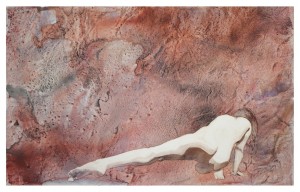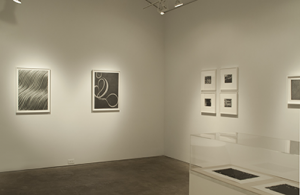Aaahhhhh. The old blog posts are all up again. It’s a shame they’re listed on the same day, but what’s one to do? That’s what happens when you don’t have a backup of your site and only manually save things. Rockin it old school is not always the best solution. Either way, I’m excited and ready to start posting again. Here I come, world! /opens arms, tosses hat like Mary Tyler Moore
Monthly Archives: August 2013
Linus Gallery’s “Body Image”
Two of the works from “Astride the Whisper of Chaos” are now on display at Linus Gallery’s “Body Image” online exhibition. Take a look at the other terrific artists and figurative pieces that were selected.
Chuck Close On Going Public
Quote
“Contrary to what’s happening with undergraduate and graduate students today — where collectors are buying their work and they’re in shows while they’re still in school — I actually had a number of opportunities to show my work, and I chose not to until 1968. That was a very conscious decision that had to do with the work. I had a very strong belief — I still do — that the act of going public is a very important decision. Everything you do from the point in which you go public is part of the public record and is out there and you cannot get it back. Anything before the time you go public is nobody’s business and you don’t have to talk about it, you don’t have to show it, you’re not responsible, you can destroy it all or whatever. But there is something about that decision, ‘OK, I think I can put my neck on the line for this work and I feel strongly enough about it that I will live with however I feel about it later. This is now part of the public realm.’”
~Chuck Close, from In the Painter’s Studio, by Joe Fig (p36)
theartblog.org Reviews “All Black” at Gallery Joe
It’s often hard to imagine monochromatic work in general, much less an entire monochromatic show with a variety of artists, feeling like much more than a dull point in a sea of invisible jewels. However, theartblog.com’s article brings a vivid and genuine vitality to this show in all black.
Magicians
Quote
“Art is the greatest deception of all. Art is a deception that creates real emotion; a lie that creates a truth. And when you give yourself over to that deception, it creates magic.”
~Marco Tempest
Impatience, Mother of Folly
“The abbreviators of works do injury to knowledge and to love, for love of anything is the offspring of knowledge, love being more fervent as knowledge is more certain, and certainty springs from a thorough knowledge of all those parts which united compose the whole…truly it is impatience, mother of folly, which praises brevity.”
~Leonardo da Vinci, c.1510
The Interference of Words
Quote
“In prose, the worst thing one can do with words is to surrender to them. When you think of a concrete object, you think wordlessly, and then, if you want to describe the thing you have been visualizing, you probably hunt about till you find the exact words that seem to fit it. When you think of something abstract you are more inclined to use words from the start, and unless you make a conscious effort to prevent it, the existing dialect will come rushing in and do the job for you, at the expense of blurring or even changing your meaning. Probably it is better to put off using words as long as possible and get one’s meaning clear as one can through pictures or sensations.”
~George Orwell “Politics and the English Language,” 1968
Brandalism:
“Any advertisement in public space that gives you no choice whether you see it or not is yours. It belongs to you. It’s yours to take, re-arrange and re-use. Asking for permission is like asking to keep a rock someone just threw at your head.”
~Banksy
To Art School or Not to Art School?
Neither attending art school nor intentionally staying away has any bearing on your success, whether we’re talking about technical/craft or art world/economic. The people who go to art school and are driven, devoted, passionate, and willful are going to be successful as artists proper (as opposed to, for instance, as commercial artists). The exact same thing applies to those of us who didn’t or who refuse to go to art school. The only difference here is that the chances of the autodidact getting a commercial gig are supremely small; that usually requires a BFA. The point is that neither provides you a greater benefit.
I got a gallery show when I was still working on my very first series. I’d only been painting for a couple months. I don’t have an immense inherent talent. The reason I got into the show was because I was painting 80+ hours a week and I acted responsibly and professionally toward the gallery director and in my submission. With that level of dedication I had amassed more hours of painting in one month than most students would in two semesters of painting classes. I could also focus on my own work because I didn’t have to produce for any classes.
There are, however, three differences that I see between the two options. The first is the technical training and critique. In art school you get the guidance that can give you the platform to go your own way. You don’t necessarily get stuck with what they’ve taught you, but if you’re responsible toward yourself and your art then you’re going to pick and choose the application of what you’ve learned. If you haven’t learned something you can’t exactly choose to accept it or reject it. Critique is also very important as you learn very quickly what your mistakes are and how to address them.
This leads to the second difference which is knowing your failures. Being an autodidact I have to make all my own mistakes, recognize that there are mistakes and what they are, and figure out on my own how to resolve them. This doesn’t necessarily get easier as you progress, either. I take a great deal of pride in my own progress, however, as I’m the only one responsible for it. In art school you are permitted to learn from the mistakes of other students and from the failures that professors can help you pre-empt by saying things like, “Now make sure you don’t do ‘x’, because every time you will get result ‘y’ which makes your drawing/painting/whatever look like shit for ‘z’ reason.” We autodidacts don’t get that kind of benefit unless we stumble on it in a book, and even then I’m never entirely sure that they’re correct because I don’t get to see that one kid in class make the exact same mistake the professor warned us about.
The third difference is community. While sites like BlueCanvas, Obsessed Artist, and Deviant Art are great, they don’t replace the sense of a physical art community. There are only a few professional artists that I know in my town because I don’t have a really clear way to find them. Galleries here happen to be scant, so perhaps that is more an issue with my location than others. Through art school you would have a wealth of people over the years from whom to choose to surround yourself and engage outside of class. Talking about aesthetics, art theory and philosophy, experiments, new techniques, some art you saw around the corner, etc., with other artists in a face-to-face dialogue has been an important aspect of artistic practice since its birth. As awesome as posting on forums and blogs actually is, people with a physical community can do this AND the other thing. Art school inherently offers this while many, if not most, of the autodidacts struggle and pine for it. I do think that some people are better left alone, and that there’s no way for us to know whether our art would be better or worse if we talked about it in a verbal dialogue with all its flux and flow that online communities just can’t do. We’re social creatures and 99% of us require social interaction to feel right and accepted, especially when it comes to our interests and even moreso when it comes to our passions. That’s the entire reason we created blogs and forums in the first place, to increase the amount of communication we can have with other people in the world because of that inherent need.
Go to art school, or don’t. The outcome of your art is only determined by your own values and virtues, not by whether or not you have a degree.
Beauty Is Infinite
Art is an attempt to grasp the infinite, to invent an innovative representative of it. We, too, are novel avatars of Being, and, like art, we so often fail. Harness the infinite; set its moments free.


